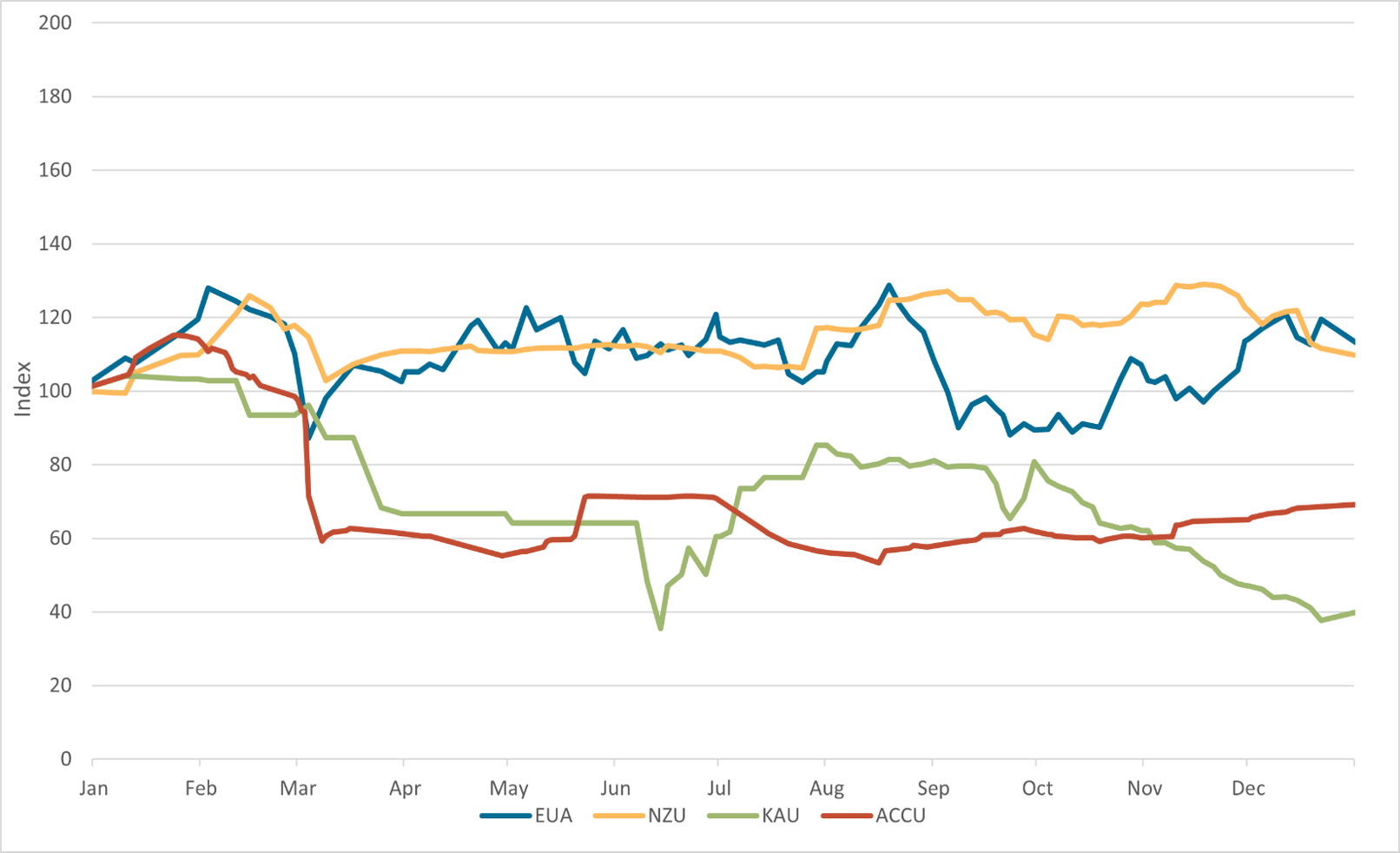International carbon markets experienced a volatile year in 2022. The initial optimism in the market was driven by a successful COP26 outcome in November 2021. In particular, the agreement on the principles of global carbon trading was a key development. Throughout 2022, the invasion of Ukraine on 24 February 2022 and local carbon policies led to different market outcomes (see Figure 3.1).
European Union Allowance (EUA) prices saw an initial 30% decline from the start of the invasion (€90 to €65 or A$142 to A$97) but peaked at €99 (A$145) in August 2022 (see Figure 3.1). The recovery was the result of higher demand for EUAs by European power generators switching from Russian gas imports to more carbon-intensive coal. This switch was due to supply concerns and forced gas consumption cuts by European Union (EU) governments to increase gas storage for winter. After the peak, EUA prices declined. Internal EU legislative negotiations (Trialogues) on carbon trading reforms considered increasing short-term auction supply to fund the REPowerEU program. Prices recovered following the discussions with proposed reforms being less bearish than the market expected. EUA prices finished the year nearly 13% higher than the start of the year (see Table 3.1).
New Zealand Units (NZU) prices were less affected by the Ukraine war, falling 16% from NZ$80 to NZ$70 (A$74 to A$66) from the start of the war to 9 March 2022 (see Figure 3.1). Prices recovered sufficiently for NZU to reach a new high in September (NZ$87 or A$78) and again in November (NZ$88 or A$82). Market bullishness was amplified by expectations that the New Zealand government would accept the Climate Change Commission's emissions trading system (ETS) reform recommendations to increase the Cost Containment Reserve trigger price. However, prices declined when the government announced only a marginal increase. NZU prices finished the year nearly 12% higher than the start of the year (see Table 3.1).
In the South Korean ETS, the Ukraine war may have contributed to the 35% decline of Korean Allowance Unit (KAU) prices from ₩31,800 to ₩20,550 (A$38 to A$23) between 24 February and 30 June 2022 (see Figure 3.1). This decline in demand is likely due to an oversupply of units. Compliance entities offloaded excess KAUs to meet carryover restrictions for the 2022 compliance period (starting on 1 July 2022). In the second half of the 2022 calendar year, there was some bullishness as the South Korean government sought to improve the ETS market activity and increase its emission reduction ambition. However, these reforms failed to gain traction and KAUs ended the year over 60% lower than the start of the year (see Table 3.1).
Changes in EUA, NZU, KAU, and generic ACCU spot prices
1 January to 31 December 2022, indexed to 1 January 2022 Note: This figure is not interactive.
Description
This graph shows indexed spot prices for EUA, NZU, KAU, and generic ACCUs over time.
Small print
Sourced from TFS Green, Jarden, Ember, Carbon News and KRX.
| Product | Spot price 31 Dec 2021 | Spot price 31 Dec 2022 | Annual change | Spot price (31 Dec 2022) Australian dollar terms* |
|---|---|---|---|---|
| European Union Allowances (EUA) | €74.61 | €84.11 | €9.50 (12.7%) | $132.84 |
| New Zealand Units (NZU) | NZ$68.50 | NZ$76.50 | NZ$8.00 (11.7%) | $71.46 |
| Korean Allowance Units (KAU) | ₩34,000 | ₩12,800 | -₩21,200 (-62.4%) | $14.86 |
*Exchange rate as at 31 December 2022